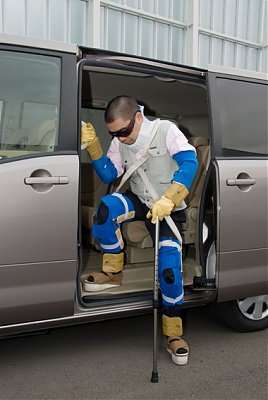|
| |||||
|
Ageing Suits For Nissan
25th February, 2008 | ||||
|
Baby boomers are commanding a bigger share of automotive sales worldwide and Nissan is meeting their needs with some lateral thinking. Nissan engineers in Japan are using a special 'suit' that simulates the physical effects of ageing. It allows engineers and designers to see car ownership through the eyes of older customers and then alter features to accommodate special needs. Nissan Design Engineer Etsuhiro Watanabe said, "As we get older, it can become harder to perform physical manoeuvres. When it comes to driving, that can mean more difficulty seeing writing on the switch gear, reach and use controls, distinguish colours on navigation equipment or get in and out of seats. Mr Watanabe said many engineers were in their 20s and 30s and the suits provided an accurate reflection of the daily physical challenges not necessarily experienced by young drivers. "It's not always practical to recruit older motorists for product research," he said, "so these special suits allow Nissan's engineers and designers to come up with solutions that make car use a safer and more positive experience." "This is a critical part of our vehicle research and shows Nissan is alert to the changing needs of drivers and at the leading edge of vehicle development." The suits can simulate poor balance through a raised front-toe design, cataract goggles simulate failing eyesight, casts on the body simulate arthritic pain by making it more difficult to raise arms and legs, and colour-deficiency goggles simulate problems distinguishing colours. Nissan engineers wearing the suits have been experimenting with the location and angles of switches, testing the ease of reading instrument and navigation panels and determining where to locate grips to make it easier to get in and out of a vehicle. The suits are being used by engineers at the Nissan Technology Centre (NTC) outside Tokyo. Work at the Centre accelerates research and advances the engineering of breakthrough technologies for Nissan's next generation of products. One feature of the suit is a thick waist-belt. About 250 mm wide and 50 mm thick it does an excellent job of duplicating what is euphemistically known as the 'middle aged spread'. The belt makes it harder to enter or exit a car and can even cramp an engineer's movement behind the steering wheel in poorly designed seating. The special suit also stiffens the engineers' flexibility, particularly with later-in-life susceptible knees and ankles. Restrictions are also built-in at the elbows using a complex system of levers. Checking on neck movement is also important as it can influence how well a driver is able to use the door mirrors and how easy - or difficult - it is to look back whilst reversing. Naturally, the research suits also give an insight into problems faced by partially disabled drivers of any age. | |||||
ABN 47106248033 |
 |
All rights reserved. |
